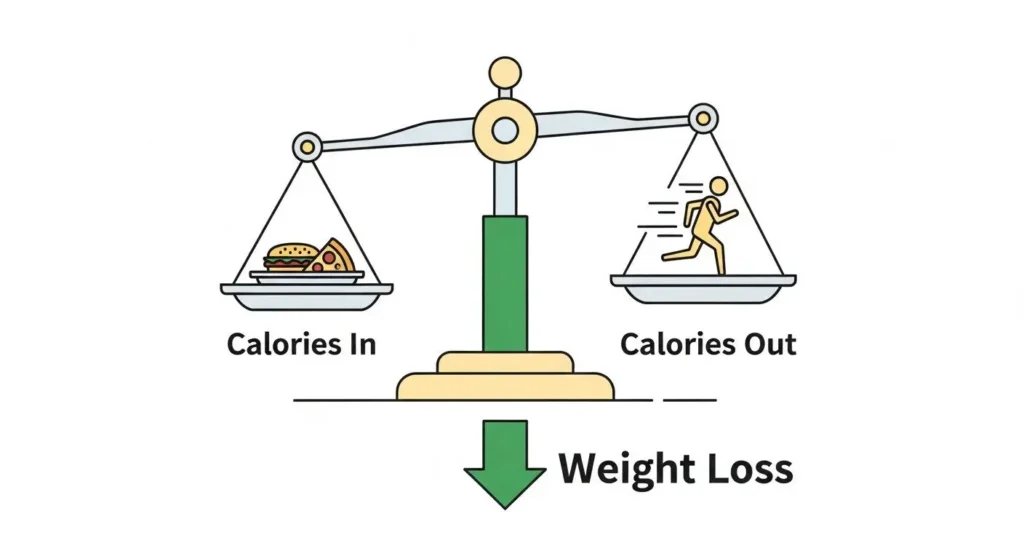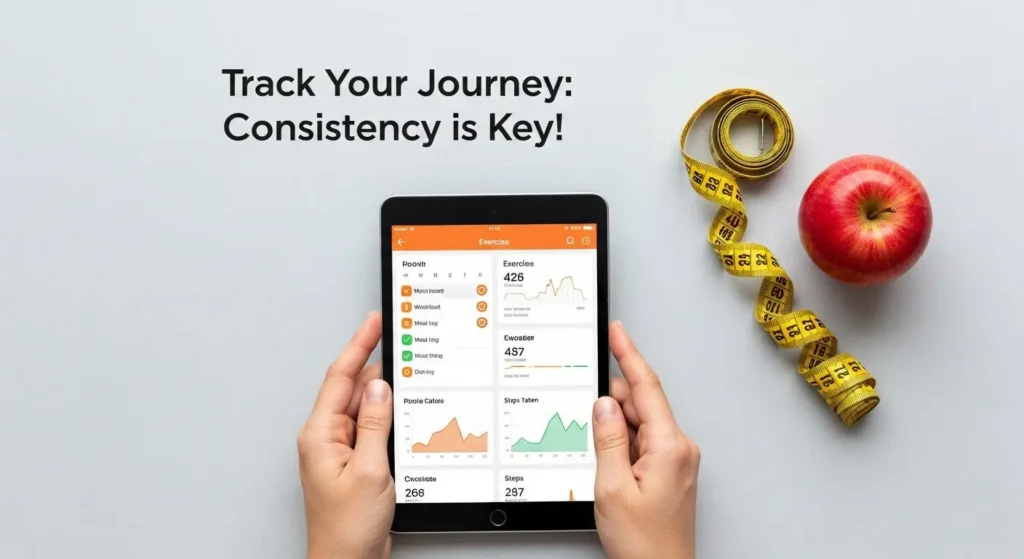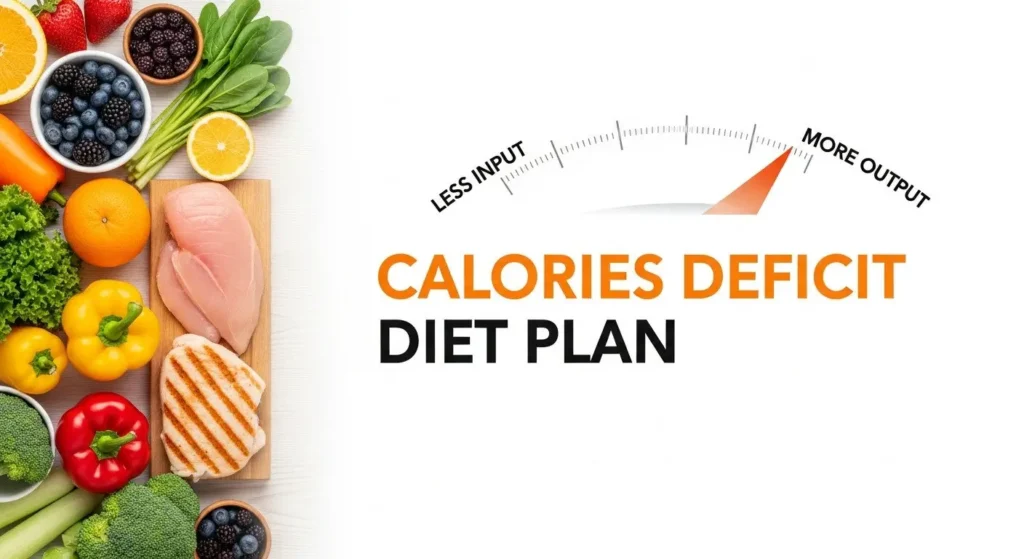Introduction
Losing weight can often feel like a complicated puzzle with countless pieces: fad diets, confusing rules, and overwhelming information. But what if we told you there's a straightforward, science-backed approach that forms the foundation of almost every successful weight loss journey? It's called a calories deficit diet plan, and it's simpler than you might think!

We're cutting through the noise to bring you “The Simple Calories Deficit Diet Plan That Works.” This guide will demystify the process, showing you exactly how to understand calories, calculate your needs, choose the right foods, and integrate simple habits that lead to real, lasting results. Forget complex restrictions; we're focusing on clear, actionable steps that empower you to take control of your health and achieve your weight loss goals. Ready to make your year of sustainable success? Let’s dive in!
What Exactly is a Calories Deficit Diet Plan?
At its heart, a calories deficit diet plan is simple math: your body needs a certain amount of energy (calories) to function every day. This energy powers everything from breathing and thinking to walking and exercising.
- Calories In: The energy you get from the food and drinks you consume.
- Calories Out: The energy your body burns through daily activities, exercise, and even just existing (your metabolism).
Here's the golden rule for weight loss: To lose weight, you must consistently eat fewer calories (Calories In) than your body burns (Calories Out).
When you create a calories deficit diet plan, your body doesn't have enough energy from food, so it starts to tap into its stored energy reserves – primarily fat. This process leads to gradual and sustainable weight loss. Think of it like a bank account: if you spend more money than you deposit, your balance goes down. If your body uses more calories than you consume, your weight goes down!

It's not about starving yourself or cutting out entire food groups. It's about being mindful of your intake and making smarter choices that keep you feeling satisfied while still achieving that deficit.
How to Calculate Your Calorie Deficit
Calculating your calorie deficit might sound tricky, but it’s a crucial first step. We’ll break it down into simple parts.
Step 1: Understand Your Basal Metabolic Rate (BMR)
Your BMR is the number of calories your body needs to perform basic, life-sustaining functions when you're at rest. This includes breathing, circulation, cell production, and maintaining body temperature. It's the minimum energy required just to exist!
Step 2: Calculate Your Total Daily Energy Expenditure (TDEE)
Your TDEE is your BMR plus the calories you burn through all your daily activities – from walking to work, doing chores, and exercising. This is the total number of calories you burn in a day.
To estimate your BMR and then your TDEE, we use formulas that consider your age, gender, height, and weight, along with your activity level. Don't worry, you don't need to be a math wizard! Our interactive calculator below will do the hard work for you.
Step 3: Create Your Calorie Deficit
Once you know your TDEE, you'll subtract a certain number of calories to create your deficit. For safe and sustainable weight loss, a common recommendation is to reduce your TDEE by 500 to 750 calories per day.
- 500-calorie deficit: Aims for about 1 pound (0.45 kg) of weight loss per week.
- 750-calorie deficit: Aims for about 1.5 pounds (0.68 kg) of weight loss per week.
Cutting too many calories can be harmful, leading to nutrient deficiencies, muscle loss, and making it harder to stick to your plan. Aim for a gradual, steady loss.
Calorie Deficit Calculator
Use our interactive tool below to estimate your daily calorie needs and discover your target calorie intake for weight loss!
Your Calorie Deficit Calculator
Your estimated Basal Metabolic Rate (BMR): calories/day
Your estimated Total Daily Energy Expenditure (TDEE): calories/day
For a healthy weight loss of about 1 lb/week, aim for a daily intake of:
calories/day
Foods to Focus On (and Foods to Limit)
Creating a calories deficit diet plan isn't just about eating less; it's about eating smarter. The quality of your calories matters immensely for your health, energy levels, and how full you feel.
Focus On These Healthy Heroes:
These foods are packed with nutrients, fiber, and protein, which help you feel full and satisfied on fewer calories.
- Lean Proteins: Chicken breast, turkey, fish (salmon, tuna), eggs, beans, lentils, tofu, Greek yogurt. Protein is super important for building and keeping muscles, and it helps you feel full for longer!
- Fruits & Vegetables: All kinds! Berries, apples, bananas, spinach, broccoli, carrots, bell peppers. They are low in calories but high in fiber, vitamins, and minerals. Aim to fill half your plate with veggies at every meal.
- Whole Grains: Oats, brown rice, quinoa, whole-wheat bread, whole-wheat pasta. These provide steady energy and lots of fiber, which helps with digestion and keeps you feeling full.
- Healthy Fats: Avocados, nuts, seeds, olive oil. While higher in calories, small amounts of healthy fats are essential for your body and can help with satiety.

Choosing these foods is a core part of a healthy eating for weight loss strategy. You might also find that approaches like a low-carb diet for weight loss naturally lead to a calories deficit diet plan because they emphasize many of these same filling, low-calorie options.
Limit These Calorie Culprits:
These foods often provide a lot of calories with little nutritional value, making it harder to stay within your deficit.
- Sugary Drinks: Sodas, fruit juices (even 100% juice can be high in sugar), sweetened teas and coffees. These are "empty calories" that don't fill you up.
- Processed Snacks: Chips, cookies, cakes, candy, most fast food. They are usually high in unhealthy fats, sugar, and sodium, and are designed to make you want more.
- Fried Foods: French fries, fried chicken, donuts. Frying adds a significant amount of unhealthy fats and calories.
- Excessive Added Sugars: Check food labels for hidden sugars in sauces, yogurts, and cereals.
Pull Quote: "Eating well is a form of self-respect. Choose foods that nourish your body and support your goals, not just your cravings."
Sample 7-Day Meal Plan (Calories Deficit Diet Plan)
This sample plan provides ideas for meals within a calories deficit diet plan. Remember to adjust portion sizes based on your calculated target calories. This plan focuses on balance, fiber, and protein to keep you full and energized.
| Meal | Monday | Tuesday | Wednesday | Thursday | Friday | Saturday | Sunday |
|---|---|---|---|---|---|---|---|
| Breakfast | Oatmeal with berries & a sprinkle of nuts (approx. 300 kcal) | Scrambled eggs (2) with spinach & whole-wheat toast (approx. 320 kcal) | Greek yogurt with fruit & a teaspoon of honey (approx. 280 kcal) | Smoothie: spinach, banana, protein powder, almond milk (approx. 350 kcal) | Oatmeal with sliced apple & cinnamon (approx. 300 kcal) | Omelet with mixed veggies & a small slice of avocado (approx. 380 kcal) | Whole-wheat pancakes (2) with light syrup & berries (approx. 350 kcal) |
| Lunch | Large mixed green salad with grilled chicken & vinaigrette (approx. 380 kcal) | Lentil soup with a small whole-wheat roll (approx. 350 kcal) | Turkey breast & veggie wrap on whole-wheat tortilla (approx. 370 kcal) | Quinoa salad with chickpeas, cucumber, tomatoes & lemon dressing (approx. 390 kcal) | Leftover dinner (e.g., salmon & veggies) (approx. 400 kcal) | Tuna salad (light mayo) on lettuce cups with side of carrots (approx. 340 kcal) | Grilled chicken sandwich on whole-wheat bread with lettuce & tomato (approx. 420 kcal) |
| Dinner | Baked salmon with roasted broccoli & brown rice (approx. 450 kcal) | Chicken stir-fry with lots of veggies & a small portion of brown rice (approx. 420 kcal) | Lean ground turkey chili with beans (no cheese/sour cream) (approx. 400 kcal) | Shrimp & veggie skewers with a small sweet potato (approx. 430 kcal) | Whole-wheat pasta with marinara sauce & lean ground beef (approx. 480 kcal) | Homemade chicken and vegetable curry (light coconut milk) (approx. 460 kcal) | Baked cod with asparagus & quinoa (approx. 400 kcal) |
| Snacks | Apple & a handful of almonds (approx. 150 kcal) | Rice cakes (2) with peanut butter (approx. 180 kcal) | Carrots & hummus (approx. 120 kcal) | Hard-boiled egg & an orange (approx. 150 kcal) | Small handful of walnuts & a pear (approx. 170 kcal) | Cottage cheese with pineapple (approx. 130 kcal) | Greek yogurt (plain) with a few berries (approx. 100 kcal) |
| Total Daily Calories (approx.) | 1280 kcal | 1270 kcal | 1170 kcal | 1350 kcal | 1400 kcal | 1310 kcal | 1270 kcal |
Note: This is an example. Your exact calorie needs will vary based on your personal calculation. Adjust portion sizes up or down to meet your specific calorie target. Always prioritize listening to your body's hunger and fullness cues.
Incorporating Exercise for Better Results
While a calories deficit diet plan is the primary driver for weight loss, adding exercise can significantly boost your results and improve your overall health in 2025. It's not just about burning extra calories; exercise offers a wealth of benefits:
- Burns More Calories: This directly helps you deepen your calories deficit diet plan or allows you to eat a little more while still losing weight.
- Builds Muscle Mass: Muscle burns more calories at rest than fat does. So, building muscle can actually boost your metabolism!
- Improves Mood & Reduces Stress: Exercise releases endorphins, which are natural mood boosters. This can help prevent emotional eating.
- Enhances Cardiovascular Health: Good for your heart and lungs, reducing risks of many chronic diseases.
- Increases Energy Levels: Regular movement can make you feel more energetic throughout the day.
Types of Exercise to Consider:
- Cardio (Aerobic Exercise): Activities that get your heart rate up.
- Walking: A fantastic, low-impact option. Aim for 30-60 minutes most days.
- Jogging/Running: More intense, burns more calories.
- Cycling: Indoors or outdoors.
- Swimming: Great full-body workout.
- Dancing: A fun way to get active!
- Strength Training: Exercises that build muscle.
- Bodyweight Exercises: Push-ups, squats, lunges, planks. No equipment needed!
- Weights: Dumbbells, resistance bands, or gym machines.
- Aim for 2-3 sessions per week, working all major muscle groups.
You don't need to become a gym fanatic overnight. Start small! Take the stairs instead of the elevator, go for a brisk walk during your lunch break, or try a short online workout video. Consistency is far more important than intensity when you're just starting out. Find activities you enjoy, and you'll be more likely to stick with them.

Tips for Success & Avoiding Common Pitfalls
Embarking on a calories deficit diet plan is a marathon, not a sprint. Here are some essential tips to help you stay on track and overcome common challenges:
- Stay Hydrated!
- Drink plenty of water throughout the day. Sometimes, thirst can be mistaken for hunger. Water also helps with metabolism and can make you feel fuller. Aim for at least 8 glasses a day.
- Prioritize Sleep
- Lack of sleep can mess with your hunger hormones (ghrelin and leptin), making you feel hungrier and crave unhealthy foods. Aim for 7-9 hours of quality sleep each night.
- Practice Mindful Eating
- Eat slowly, savor your food, and pay attention to your body's hunger and fullness signals. Avoid distractions like TV or your phone. This helps you recognize when you're truly satisfied, preventing overeating.
- Master Portion Control
- Even healthy foods have calories. Use measuring cups, a food scale, or simply learn to eyeball appropriate portions. Eating from smaller plates can also help!
- Plan Ahead
- Meal prepping or simply planning your meals and snacks for the week can prevent impulsive, unhealthy food choices when hunger strikes.
- Don't Fear Healthy Fats & Fiber
- These nutrients are crucial for satiety. Foods rich in fiber (fruits, veggies, whole grains) and healthy fats (avocado, nuts) will keep you feeling full longer, making it easier to stick to your deficit.
- Manage Hunger Pangs Naturally
- When hunger hits between meals, first try drinking water. If still hungry, opt for a high-protein, high-fiber snack like Greek yogurt, an apple with a few almonds, or some veggie sticks.
- Some people find that strategies like intermittent fasting for weight loss can help manage hunger by structuring eating windows, but always ensure it fits within your overall calories deficit diet plan.
- Deal with Plateaus
- It's normal for weight loss to slow down or stop for a period. Don't get discouraged! Re-evaluate your calorie intake, increase your activity, or try cycling your calories slightly. Your body adapts, so sometimes you need to shake things up.
- Address Emotional Eating
- Are you eating when stressed, bored, or sad? Identify these triggers and find alternative coping mechanisms like going for a walk, calling a friend, or engaging in a hobby.
Pull Quote: "Small, consistent changes lead to big, lasting results. Celebrate every step of your journey!"
Monitoring Progress & Adjusting Your Plan
Seeing progress is incredibly motivating! However, the scale isn't the only measure of success, and weight loss isn't always linear.
How to Monitor Your Progress:
- Weekly Weigh-ins: Weigh yourself once a week, at the same time (e.g., Monday morning after using the restroom). Don't obsess over daily fluctuations; the weekly trend is what matters.
- Body Measurements: Use a tape measure to track changes in your waist, hips, thighs, and arms every 2-4 weeks. Sometimes, you might lose inches even if the scale doesn't move much (especially if you're building muscle!).
- How Your Clothes Fit: This is a fantastic non-scale victory! Noticing your clothes feel looser can be a huge motivator.
- Progress Photos: Take photos every month or two. Visual changes can be very encouraging.
- Energy Levels & Mood: Pay attention to how you feel. Are you more energetic? Sleeping better? These are all signs of progress.
- Food & Exercise Journal: Briefly tracking what you eat and your activity levels can help you stay accountable and identify patterns.
When to Adjust Your Plan:
- Weight Loss Stalls: If you haven't seen any change on the scale or in measurements for 2-3 weeks, it might be time to recalculate your TDEE (as your weight changes, so do your calorie needs) or slightly increase your activity.
- Feeling Too Hungry/Tired: If you're constantly ravenous or exhausted, your calories deficit diet plan might be too aggressive. Consider increasing your intake by 100-200 calories and focusing more on nutrient-dense, filling foods.
- Feeling Great! If you're consistently losing weight and feeling good, keep doing what you're doing!
Remember, your body adapts. What worked perfectly at the beginning might need slight tweaks a few months down the line. Be patient and flexible with your approach.

The Importance of Consistency and Patience
In a world of instant gratification, it's easy to get frustrated when weight doesn't come off as quickly as you'd like. However, sustainable weight loss with a calories deficit diet plan is a journey that requires both consistency and patience.
- Consistency is Key: It's not about being perfect every day, but about being consistent most days. One "off" meal or day won't derail your progress, but a consistent pattern of unhealthy choices will. Aim for 80/20 – stick to your plan 80% of the time, and allow for flexibility 20% of the time. This makes the diet more sustainable.
- Patience Pays Off: Healthy weight loss is typically 1-2 pounds per week. This might seem slow, but it's effective and more likely to last. Rapid weight loss often leads to muscle loss and rebound weight gain. Trust the process, celebrate small victories, and focus on building healthy habits for life.
Pull Quote: "Success isn't always about greatness. It's about consistency. Consistent hard work leads to success. Greatness will come."
When to Consult a Professional
While a calories deficit diet plan is generally safe and effective for most healthy adults, there are situations where consulting a healthcare professional is highly recommended:
- Pre-existing Health Conditions: If you have conditions like diabetes, heart disease, kidney disease, or high blood pressure (learn more about hypertension treatments), always talk to your doctor before making significant dietary changes. They can ensure the plan is safe and appropriate for your specific needs.
- Taking Medications: Certain medications can affect metabolism or interact with specific foods. A doctor or dietitian can provide guidance.
- Significant Weight to Lose: If you have a large amount of weight to lose, professional guidance can help create a structured, safe, and effective plan tailored to you.
- Eating Disorders: If you have a history of or suspect you have an eating disorder, seek help from a qualified mental health professional or eating disorder specialist.
- Not Seeing Results or Feeling Unwell: If you're consistently following a plan but not seeing results, or if you're experiencing fatigue, dizziness, or other concerning symptoms, consult a doctor or registered dietitian. They can help identify underlying issues or adjust your approach.
- Pregnant or Breastfeeding: Calorie needs are different during these periods. Always consult a healthcare provider.
For general guidance on maintaining a healthy weight loss diet, a registered dietitian can provide personalized advice and support.
Conclusion
The simple calories deficit diet plan is not a fad; it's a fundamental principle of weight loss that has stood the test of time. By understanding how calories work, calculating your individual needs, and making smart, consistent food choices, you can effectively and sustainably reach your weight loss goals.
Remember, this journey is about progress, not perfection. Focus on nourishing your body with whole foods, staying active, prioritizing sleep, and being patient with yourself. With the right mindset and these actionable steps, you have all the tools you need to create a healthier, happier you.








